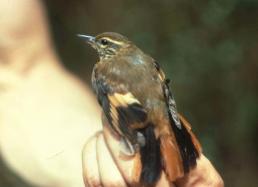Blog #6: On the Trail
In the morning when I’m out surveying birds, one of the things I’m always hoping to hear ahead of me, or not too far distant from the trail, is the sound of a species like the Fulvous Shrike Tanager (Lanio fulvus—see above photo) in the canopy, or one of the woodcreepers that can be found in either the midstory or the canopy. Why these particular species? Because they’re typical members—or even leaders—of canopy mixed flocks. So when I hear their calls, I know many other species will likely be accompanying them, creating a bonanza bird-surveying experience for me.
Mixed-species flocks are primary centers of activity in any Amazonian forest, and there are several different types of mixed flocks. A number of antwrens, antpittas, and antbird species, such as the Bicolored Antbird (Gymnopithys leucaspis—see Photo #1 below), have evolved to specialize in foraging above army ant swarms on the forest floor. These birds swoop in to catch fleeing invertebrates and small vertebrates that are trying to escape the advancing ants. When observing flocks at an ant swarm, you always need to be mindful of where you’re standing, or you’ll end up being covered in biting ants!
There are also flocks that contain a set of species that specialize in the mid-canopy and are—with a few exceptions—different than those you would see in a canopy flock. This layering of different guilds of birds in the many available habitat niches is one of the ways in which diversity in Amazonia has evolved to be so rich.
As I approach the mixed canopy flock, I begin to hear birds long before I can see them. It’s possible to pick out several of the many different species that are foraging together—often 30 to 40 meters (around 100 to 130 feet) up in the trees—just by knowing their vocalizations. The presence and position of the light coming down into the forest is a critical factor with respect to what can be spotted. Overcast days sometimes make it impossible to spot anything more than silhouettes of birds darting in and out of the foliage.
When there’s good light, I hope to find a decent angle for viewing up into the canopy, where all the activity is. First I look for movement, and then I quickly bring my binoculars up to my eyes to lock onto where that movement was. Hopefully the bird is still sitting there, banging away at a bug on a branch or searching around for the next best hunting perch.
Some species are so distinctive that they can be identified with just a short glimpse. For example, a rusty red tail is likely to be one of several species of foliage-gleaners (although female Tachyphonus tanagers also have reddish tails, as do woodcreepers). A greenish tinted bird that lands on larger branches is likely to be one of several species of woodpeckers. A medium-sized blackish bird with a long, black tail is a nunbird (and since they often occur in family groups, there will usually be more than one). With experience, each time you spy something flying, your mind will tick through the possibilities: “…that’s a trogon (broad wings, square tail), that’s a xenops (small size, with red and black in the tail—see Photo #2 below)...” etc.
The number of species typically represented in a mixed flock is approximately 20-40. More often than not, you’ll get only a quick glimpse of just a few of these in attendance. The small flycatchers may be the biggest challenge to identify because there are plenty of possibilities, and from far below, you’re often seeing only the belly and the throat. Sometimes a small flycatcher may be sitting out in the open and in the same spot for quite some time, but you just cannot get a view of it that tells you for certain what species it is. If it calls to a flock member, that vocalization can help identify it.
These flocks are generally on the move, and individual birds are joining and leaving the flock as it travels, so you rarely feel that you’ve seen every bird in the flock. Too quickly, you’ll often start to see individuals heading off, one by one, in the same direction. At that point, you’ll have a decision to make. If they’re heading along the trail, it’s easy to follow them, but if they’re heading into the forest, how far off the trail are you willing to wander to watch them more?
Through years of experience with getting disoriented—and even completely lost—I’ve developed the habit of quickly looking around me to try and burn into my brain some detail that will remind me of what the forest along the trail looks like. Then, I head off the trail, trying to find upward angles to see birds high in the canopy. The calls and flashes of movement help direct my path as I change direction frequently to work my way around tree falls. But I have to keep in mind that, if I’m always looking up, I’m not paying as much attention to the direction I’m going.
At these times, my thoughts are torn between the flock and not getting lost, but usually my attention is mostly on the flock. My neck gets sore from straining and staring upwards, scanning though the windows of foliage into the treetops. When I finally stop to look around me, I often have that feeling that I’m not positive which way I need to go to reconnect with the route back to the boat, but it has always been worth the risk. Mixed flocks are one of the most exciting and challenging aspects of avian diversity in tropical forests.
More soon,
John






